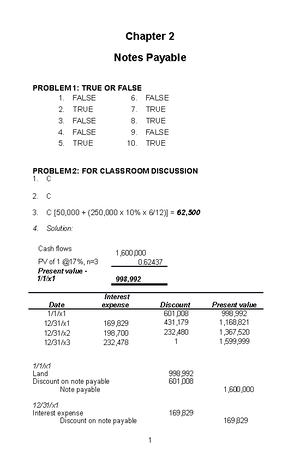- Information
- AI Chat
Was this document helpful?
Intermediate Accounting: Contingent Liability and Bonds payable
Course: Intermediate accounting (ACC 205)
252 Documents
Students shared 252 documents in this course
University: Batangas State University
Was this document helpful?

Colegio de Sto. Domingo de Silos Inc.
Barangay Gulod, Calatagan, Batangas
INTERMEDIATE ACCOUNTING 2
MIDTERM EXAMINATION
NAME: DATE:
SECTION:
INSTRUCTIONS: Select the correct answer for each of the following questions. Mark only one answer for
each item by shading the box corresponding to your answer on the answer sheet provided. STRICTLY
NO ERASURES. Anyone caught cheating will receive a failing grade or 5 on this subject.
I. TRUE OR FALSE. Write TRUE if the statement is correct and FALSE if the statement is wrong.
1. Bond issues that mature in installments are called serial bonds.
2. The interest rate written in the terms of the bond indenture is called the effective yield or market rate.
3. Amortization of a premium increases bond interest expense, while amortization of a discount decreases
bond interest expense.
4. If a company plans to retire long-term debt from a bond retirement fund, it should report the debt as
current.
5. A mortgage bond is referred to as a debenture bond.
6. The cash paid for interest will always be greater than interest expense when using effective-interest
amortization for a bond.
7. Bond issues that mature in installments are called term bonds.
8. Premiums are considered as an outright gain of the issuing entity.
9. There is a discount when the face amount of the bonds is greater than the its present value.
10. Bond issue costs are costs directly attributable to the issue of bonds payable.
II. MULTIPLE CHOICE. Shade the letter of the best answer.
11. The covenants and other terms of the agreement between the issuer of bonds and the lender are set
forth in the
a. bond indenture. c. registered bond.
b. bond debenture. d. bond coupon.
12. The term used for bonds that are unsecured as to principal is
a. junk bonds. c. indebenture bonds.
b. debenture bonds. d. callable bonds
13. Bonds for which the owners' names are not registered with the issuing corporation are called
a. bearer bonds. c. debenture bonds.
b. term bonds. d. secured bonds.
14. The interest rate written in the terms of the bond indenture is known as the
a. coupon rate. c. stated rate.
b. nominal rate. d. coupon rate, nominal rate, or stated rate.
15. The rate of interest actually earned by bondholders is called the
a. stated rate. c. effective rate.
b. yield rate. d. effective, yield, or market rate.
16. A provision shall be recognized when:
a. An entity ha a present obligation
b. It is probable that an outflow of resources is required to settle the obligation
c. A reliable estimate of the amount of the obligation can be made.
d. All of the above.
17. First statement: A contingent liability is a present obligation that arises from past events but is not
recognized.









